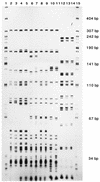Genetic organization of the mecA region in methicillin-susceptible and methicillin-resistant strains of Staphylococcus sciuri
- PMID: 9440511
- PMCID: PMC106877
- DOI: 10.1128/JB.180.2.236-242.1998
Genetic organization of the mecA region in methicillin-susceptible and methicillin-resistant strains of Staphylococcus sciuri
Abstract
A homolog of the Staphylococcus aureus methicillin resistance gene mecA was recently shown to be ubiquitous in independent isolates of the animal species Staphylococcus sciuri. The mecA gene homolog and regions flanking it were cloned and sequenced from four strains of S. sciuri: strain K1 (ATCC 29062), a representative of S. sciuri subsp. sciuri; two strains (K3 and K8) representing S. sciuri subsp. rodentius; and strain K11, a representative of S. sciuri subsp. carnaticum. Strains K1 and K11 were susceptible to methicillin, while strains K3 and K8 showed heterogeneous resistance. The mecA genes of strains K1 and K11 and one of the two copies of mecA (mecA1) present in strain K3 had virtually identical DNA sequences in the mecA gene and were similar in genetic organization in the flanking regions. In contrast, the single copy of mecA in strain K8 and the second copy of mecA (mecA2) in strain K3 had mecA DNA sequences identical to that of S. aureus mecA, and the mecA region in these two strains was also similar to that of the same region in the S. aureus strain used for comparison. Interestingly, an open reading frame defining an N-terminal truncated polypeptide, NTORF101, with a high degree of homology to a DNA segment in the hypervariable region of methicillin-resistant S. aureus (and also similar to the Escherichia coli gene ugpQ) was also identified downstream of the mecA homolog of strain K11, representing S. sciuri subsp. carnaticum. The ugpQ-like gene is not present in methicillin-susceptible strains of S. aureus. The presence of such a ugpQ-like gene together with the homolog of mecA in strain K11 supports the speculation that these genetic elements may be evolutionary relatives and/or precursors of the genetic determinant of methicillin resistance in S. aureus.
Figures




References
-
- Archer G L, Niemeyer D M. Origin and evolution of DNA associated with resistance to methicillin in staphylococci. Trends Microbiol. 1994;2:343–347. - PubMed
-
- Ausubel F M, Brent R, Kingston R E, Moore D D, Seidman J G, Smith J A, Struhl K, editors. Short protocols in molecular biology. New York, N.Y: Greene Publishing Associates and John Wiley; 1992.
-
- Barberis-Maino L, Berger-Bächi B, Weber H, Beck W D, Kayser F H. IS431, a staphylococcal insertion sequence-like element related to IS26 from Proteus vulgaris. Gene. 1987;59:107–113. - PubMed
Publication types
MeSH terms
Substances
Associated data
- Actions
- Actions
- Actions
- Actions
- Actions
LinkOut - more resources
Full Text Sources
Other Literature Sources
Molecular Biology Databases
Research Materials

